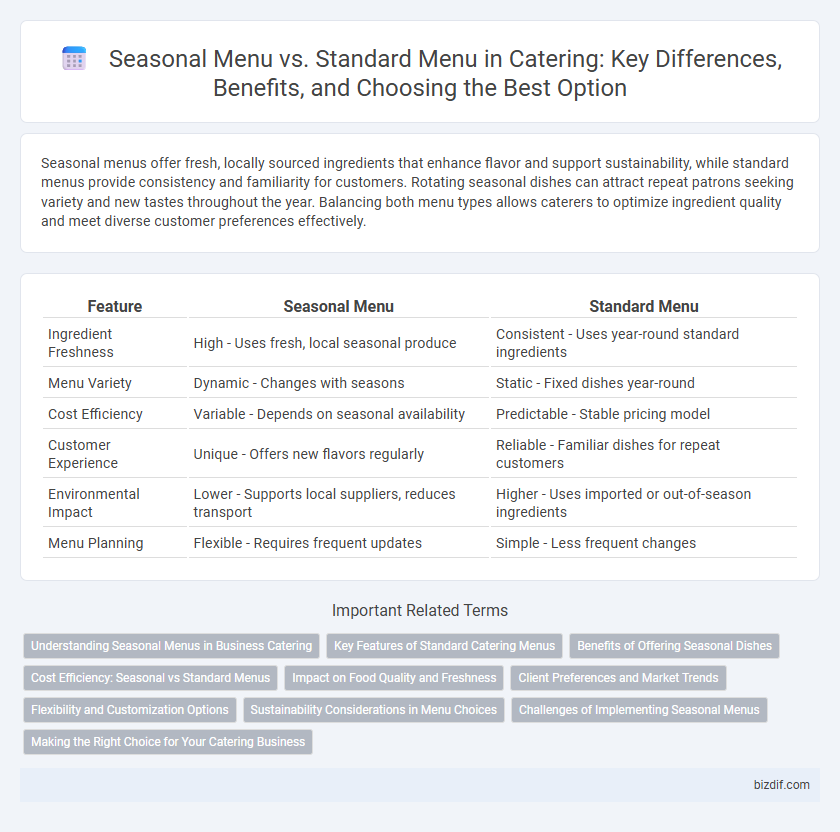Seasonal menus offer fresh, locally sourced ingredients that enhance flavor and support sustainability, while standard menus provide consistency and familiarity for customers. Rotating seasonal dishes can attract repeat patrons seeking variety and new tastes throughout the year. Balancing both menu types allows caterers to optimize ingredient quality and meet diverse customer preferences effectively.
Table of Comparison
| Feature | Seasonal Menu | Standard Menu |
|---|---|---|
| Ingredient Freshness | High - Uses fresh, local seasonal produce | Consistent - Uses year-round standard ingredients |
| Menu Variety | Dynamic - Changes with seasons | Static - Fixed dishes year-round |
| Cost Efficiency | Variable - Depends on seasonal availability | Predictable - Stable pricing model |
| Customer Experience | Unique - Offers new flavors regularly | Reliable - Familiar dishes for repeat customers |
| Environmental Impact | Lower - Supports local suppliers, reduces transport | Higher - Uses imported or out-of-season ingredients |
| Menu Planning | Flexible - Requires frequent updates | Simple - Less frequent changes |
Understanding Seasonal Menus in Business Catering
Seasonal menus in business catering leverage fresh, locally sourced ingredients that align with specific times of the year, enhancing flavor and presentation while often reducing costs. Incorporating seasonal dishes can boost client satisfaction by offering variety and highlighting current food trends, making each event feel unique and thoughtfully curated. This approach also supports sustainability goals, reflecting a business's commitment to environmental responsibility and quality.
Key Features of Standard Catering Menus
Standard catering menus prioritize consistent availability and familiar dishes, ensuring dependable options for diverse clientele. These menus typically feature classic, crowd-pleasing dishes with established recipes and portion sizes, facilitating efficient preparation and service. Emphasis on scalability and cost control with standard ingredients helps streamline operations and maintain budget predictability.
Benefits of Offering Seasonal Dishes
Offering seasonal dishes in catering enhances menu freshness and flavor by utilizing ingredients at their peak quality and availability. Seasonal menus support sustainability by reducing transportation emissions and food waste while aligning with local agricultural cycles. Clients enjoy diverse, innovative dining experiences that reflect current trends and regional specialties, increasing customer satisfaction and repeat business.
Cost Efficiency: Seasonal vs Standard Menus
Seasonal menus enhance cost efficiency by leveraging locally sourced, in-season ingredients, which typically reduce procurement expenses and minimize waste compared to standard menus reliant on imported or out-of-season items. Standard menus often incur higher costs due to consistent use of non-seasonal ingredients that fluctuate in price and availability. Emphasizing seasonal produce and market trends allows catering services to optimize budget allocation and improve profit margins.
Impact on Food Quality and Freshness
Seasonal menus prioritize ingredients at peak ripeness, enhancing flavor intensity and nutritional value compared to standard menus that use year-round available produce. Utilizing local, seasonal products reduces time from farm to table, preserving freshness and minimizing nutrient degradation. This approach supports sustainable sourcing and allows chefs to innovate with diverse, high-quality dishes reflecting current harvests.
Client Preferences and Market Trends
Seasonal menus offer tailored options that align with client preferences for fresh, locally sourced ingredients, enhancing satisfaction and perceived quality. Market trends show a growing demand for sustainable and health-conscious choices, making seasonal menus more appealing than standard, year-round offerings. Catering businesses adopting seasonal menus can differentiate themselves and respond promptly to evolving consumer tastes.
Flexibility and Customization Options
Seasonal menus offer greater flexibility by incorporating fresh, locally sourced ingredients tailored to specific times of the year, enhancing flavor and nutritional value. Standard menus provide consistency and ease of planning but lack the adaptability to accommodate changing customer preferences or dietary trends. Catering services benefit from seasonal menus by delivering highly customizable options that align with event themes and client needs, resulting in a more personalized dining experience.
Sustainability Considerations in Menu Choices
Seasonal menus prioritize locally sourced, in-season ingredients that reduce carbon footprints and support sustainable agriculture, enhancing environmental responsibility. Standard menus often rely on imported or out-of-season produce, increasing energy consumption and food miles, which can impact sustainability negatively. Choosing a seasonal menu allows caterers to minimize waste and promote ecological balance through ingredient freshness and regional availability.
Challenges of Implementing Seasonal Menus
Implementing seasonal menus presents challenges such as fluctuating ingredient availability, which can disrupt supply chains and complicate inventory management. Chefs must adapt recipes regularly, requiring continuous culinary innovation and staff training to maintain consistent quality. Additionally, customer expectations can vary with seasonal offerings, making it essential to balance creativity with familiar options to ensure broad appeal.
Making the Right Choice for Your Catering Business
Choosing between a seasonal menu and a standard menu significantly impacts your catering business's appeal and profitability. Seasonal menus leverage fresh, locally sourced ingredients, enhancing flavor and sustainability while attracting environmentally conscious clients. Standard menus provide consistency and ease in inventory management, ensuring reliable service and cost control throughout the year.
Seasonal Menu vs Standard Menu Infographic

 bizdif.com
bizdif.com